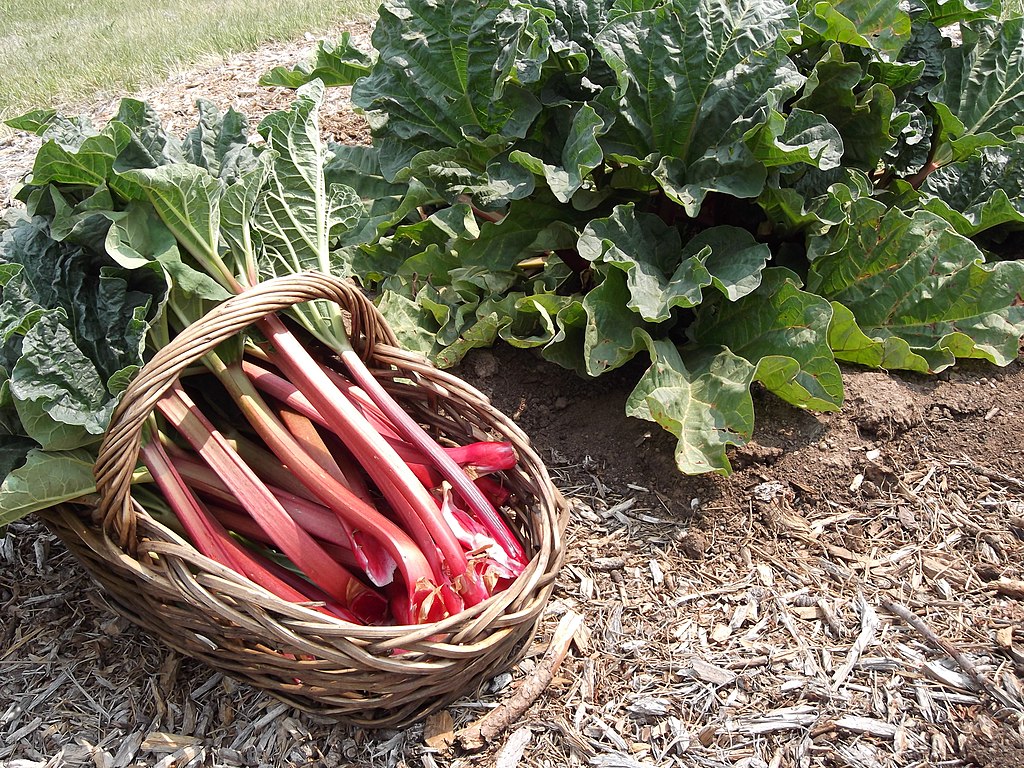To rhubarb or not to rhubarb?

MILAN, Ill. — I hope I am not the only one with a plant they have always been aware of yet never really paid attention to. For me, that is rhubarb.
I recall my grandmother having a stand of rhubarb, and I am sure she made rhubarb pie, but that is where my memory stops. I do not recall eating rhubarb pie or any other baked good or preserve made from the early summer delicacy. Only recently, has rhubarb been a more conscious part of my gardening life.
Rhubarb is a perennial vegetable that grows well throughout the United States and is one of the first crops ready for harvest in the spring. Properly planted and cared for rhubarb plants may be productive for five or more years.
Rhubarb plants require full sun, and nutrient-rich, well-drained soil. Known as a heavy-feeding plant, a soil test is recommended for nutrient analysis more than soil pH. Supplemental nutrients are often needed to grow healthy productive plants. Based on a soil test, an annual application of balanced commercial fertilizer and/or compost will encourage the development of large stocks and leaves for harvesting. Rhubarb is tolerant of a wide range of soil pH levels.
Rhubarb should be planted or divided in early spring while the plants are dormant. Growing rhubarb from seed is an option, however, not all varieties are available as seed. Purchasing plants or dividing existing plants is recommended. Provide adequate spacing for these large plants by planting rhubarb plants 36 to 48 inches apart in rows two to three feet apart. Plant the roots of rhubarb so the crown bud is two inches below the surface of the soil.
As plants age, it may be necessary to divide large plants to improve health and vigor. Divide rhubarb in early spring as new growth begins to emerge. Use a clean, sharp shovel to cut the plant into smaller pieces. Each new section must have at least one strong bud to transplant successfully. At the time of division, it may be desirable to relocate the rhubarb patch due to the large consumption of nutrients.
Insect pests are usually not a problem for rhubarb except for a snout beetle, Rhubarb curculio. Snout beetle are dark-colored insects measuring 1/2 to 3/4 of an inch long. They bore into the stocks, crowns, and roots of rhubarb plants. Keep weeds well managed around a rhubarb planting, especially grass, and dock, a host plant for the beetle. Treat rhubarb with a suggested insecticide according to label instructions or destroy the infected plant parts after July once beetles have laid their eggs.
Grown for its petioles, or leaf stalks, varieties are available in red or white. Do not harvest rhubarb during the first year of planting, new plants need all their foliage to feed a developing root system. During the second year of growth, a light harvest can occur for one to two weeks. During the third and subsequent years, plants have become established, and a full harvest can occur lasting eight to ten weeks.
To harvest rhubarb, hold the stock firmly, and pull and twist the leaf stock from the plant. Do not use a knife to cut stocks, the knife can spread disease from plant to plant. Once harvested, use a knife to remove the leaf blades from the stalk. Do not consume leaf blades, they contain large amounts of oxalic acid which can limit the body’s ability to take up calcium. Stalks should be crisp and thick when harvested.
If flower stalks develop, remove them from the base of the plant as soon as they appear. Do not consume rhubarb if a hard freeze has affected the plant. A freeze event can negatively impact texture and flavor and cause oxalic acid to move from the leaf blade into the petiole.
Raw rhubarb has a tart flavor often buffered by the addition of sugar before consumption and used to make pies, tarts, jam, and other treats. Rhubarb is often paired with other flavors, such as lemon or strawberry.
To freeze rhubarb, chop into ½-inch pieces, spread them on a sheet pan, and place in the freezer. Once frozen, transfer the rhubarb into a plastic freezer bag, seal it tightly, and put it back into the freezer. Frozen rhubarb will keep for up to six months.
To cook with fresh rhubarb, use a vegetable peeler or paring knife to remove any brown or scaly spots. Prepare for use by trimming the ends of the stocks then wash and dry.
Rhubarb is acidic and should always be cooked using a non-reactive pan such as anodized aluminum, stainless steel, or enamel-coated cast iron cookware. When cooked in a reactive metal pot, rhubarb develops an unappetizing brown color on both the rhubarb and cookware.
Rhubarb recipes can be akin to family heirlooms and pies reign supreme. If your family doesn’t have a tried and true recipe or you are looking to try something different, here is a Rhubarb Berry Crisp I highly recommend.
Filling:
- 2 cups hulled and quartered strawberries
- 1 cup blueberries
- 1 cup rhubarb (1/4-to-1/2-inch slices)
- 1 tablespoon cornstarch
- 1/3 cup honey
- 1 teaspoon vanilla
- 2 tablespoons lemon juice
Topping:
- ¾ cup old-fashioned oats
- ¾ cup flour
- 1/3 cup lightly packed brown sugar
- 1/8 teaspoon salt
- 4 tablespoons butter, melted
- 3 tablespoons plain yogurt
Preheat oven to 375 degrees Fahrenheit. Grease a 2-quart baking dish. In a large bowl, mix together berries, rhubarb, honey, cornstarch, vanilla and lemon juice. Pour mixture in baking dish. In a medium bowl, stir the oats, flour, brown sugar and salt. Add the butter and yogurt and stir until all ingredients are incorporated. Spread topping over the filling. Bake uncovered for 40 minutes or until fruit is juicy and bubbling and the top is golden brown. Let the crisp cool for 10 minutes before serving. Serve with vanilla ice cream or whipped cream on the side!
Yield: 9 servings
Nutrition Facts (per serving): 200 calories, 6 grams fat, 80 milligrams sodium, 35 grams carbohydrate, 2 grams fiber, 3 grams protein
Miss Clipping Out Stories to Save for Later?
Click the Purchase Story button below to order a print of this story. We will print it for you on matte photo paper to keep forever.

